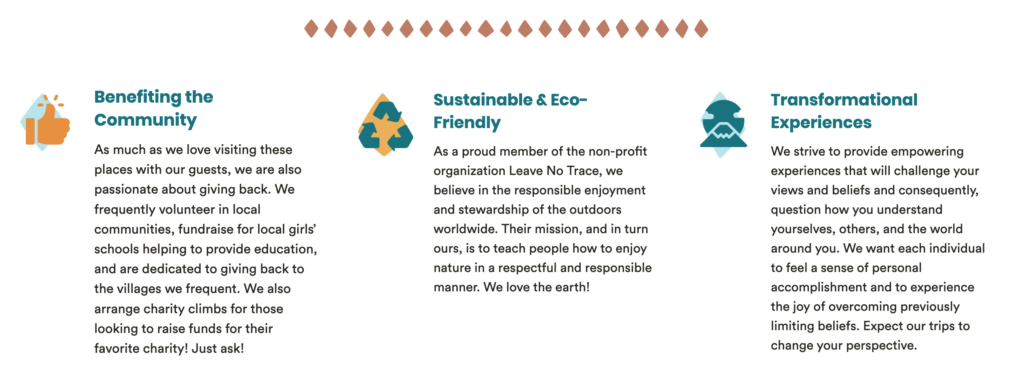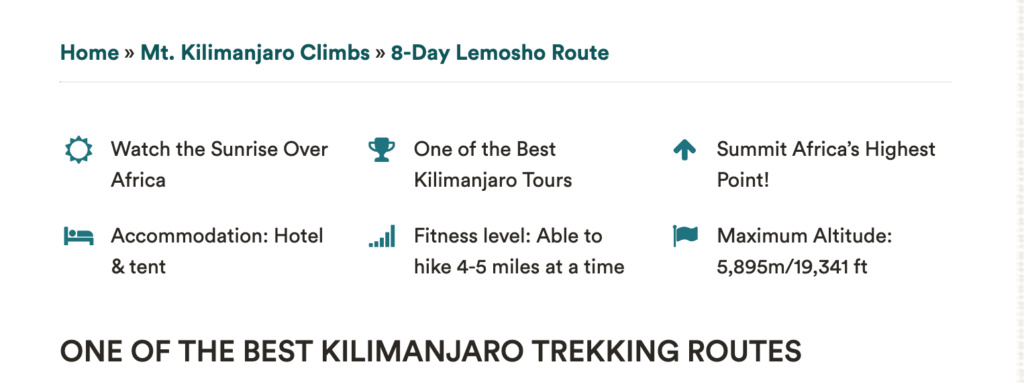Identifying your Unique Selling Points/Propositions (USPs) is an essential marketing strategy for any business, and a tour operator is no exception. It should be a key part of your business plan and marketing strategy, as it is fundamental to addressing who exactly you want to attract to book your tours.
As a tour operator, you wouldn’t want to launch a tour unless every aspect of it has been carefully considered and planned. Launching a website is no different, and having your USPs clearly marked out on the homepage of your website helps customers efficiently decide whether your tours are right for them.
Here at Tourism Tiger, we’ve launched hundreds of websites and during each project we’ve helped our clients define their USPs for their website. This is one of the many reasons why we’re specialists in helping tour businesses sell more tours. Helping our clients identify their USPs and making them eye-catching on their homepage is all part of our service and we’ve decided to share some of that expertise with you.
Identifying USPs as a New Tour Operator
Sitting down and working out what your USPs are when you’re starting out can feel like an overwhelming task for many. It’s good to talk with those you trust (opinion-wise) as well as some fellow business owners to see how they may perceive you and your business.
It is also important to consider the meaning of a unique selling proposition carefully. This means that you are looking for the specifics within your tour operation that make it stand out from the competition. If you are a tour company offering walking tours of New York City, the destination as a whole would not be a USP, instead you would be looking for what makes your walking tour the best. That could mean you go to specific locations within the city that other tour operators don’t, offer family-friendly tours or specialise in small-group tours. When it comes to identifying your USPs, there are countless options, you just have to approach the subject the right way.
Here are some questions to ask yourself that may help generate USP ideas:
- Do you offer a tour or activity that nobody else in your city/region/area does?
- Are you looking to be more sustainable compared to your competitors?
- Are you looking to actively engage with your local community?
- Can you offer exclusivity? i.e. tours to places other tour operators can’t go
- Are you and/or your guides passionate locals or experts in their fields?
- Do you offer flexibility or customization of your tours?
- Can you offer your guests quality/safety assurances via certifications?
- Are you based in a unique location with few or no competitors?
Asking these kinds of questions is a great starting point if you are stuck for what you want your tour business to say to your potential customers. Communicating what makes your tours special is essential to your brand strategy so be sure to do your research.
Identifying USPs as an Established Tour Operator
If you have been in business for some time then you may already know what your core strengths are and in turn have a good understanding of your USPs. However, even as an established tour business you may find asking yourself the questions listed above useful if you’re looking to refresh your USPs.
And as any good business owner knows, it is important to listen to people. Speaking with one of your partners or trusted fellow business owners is also important, especially if they operate in the same region as you or even in the same industry. The stories they hear about you and pass on may give you a fresh perspective on your tour business. Additionally, finding out from your guests what they loved most about taking a tour with you helps you form a clearer, and often different, picture to the one you may envisage you’re selling.
Aside from speaking to your guests directly during and after tours, reading your testimonials on sites such as Yelp, Google and TripAdvisor is a great way of researching and generating ideas for at least one of your USPs. As you read through your reviews, consider which words and phrases keep popping up and do your customers focus on your personality (or that of your guides), the itinerary of your tours or perhaps something else entirely? You might be surprised at what you find.

Iconography
If you really want your USPs to catch the attention of visitors to your website, then having customized icons to go with them helps reinforce your message and creates a perfect pairing. Conveying messages via icons has been crucial to communication from the beginning of human civilization and that remains the case today – think how we use emojis in everyday conversation on our phones. An icon can often convey a message or emotion much quicker than words and also often serves as a nice visual break from the text.
Icons should be as simple as possible but also appealing in their design in order to convey your message effectively. If you buy a custom built website from us(opens in a new tab), we will design and tailor icons that compliment your USPs and make them stand out. This has proven to grow tour businesses and sell more tours(opens in a new tab), so get in touch with us for your expert website building needs.

Tour USPs
In addition to identifying the USPs for your business, you should also consider the USPs for each of your tours or services. When a potential guest clicks on a tour page, it is important that they are presented with easy-to-read and concise copy. The value of listing 3 to 4 USPs at the top of each tour page, again accompanied by icons, really helps to highlight what you are trying to sell in a quick and attractive way. Think about what makes that individual tour special, both in terms of your offerings and that of the market. Naturally, many of the same principles and questions used to help identify your company USPs can also be used for your tour USPs.

Moving With The Times
As with any business, a tour operator should always look to see if they can move with the times. For example, if you established your USPs pre-pandemic, it is definitely time to revise them. Many scholars agree that tourist habits have now changed, possibly forever, due to the impact of Covid-19. Therefore looking to see what guests are attracted to in the present. could well be different from just a few years in our ever-changing world.
As the travel intelligence specialists, Forward Keys(opens in a new tab), found in their studies during the pandemic, “[t]rends that simmered below the surface before COVID-19 have emerged with urgency in 2020. Over the last few years, for example, your destination marketing organization (DMO) might have started to make responsible travel messaging a priority to address visitor pressure due to mass tourism. Fast forward to today’s physical distancing rules, and suddenly this work is even more urgent.”
With this in mind, messages focused on sustainability and caring for the environment are more important than ever. The ability to offer small-group tours and private excursions is also crucial at easing guest fears about Covid-19. However you decide to move forward with your USP choices, be sure to do your research and ask yourself the necessary questions (such as those listed in this blog) to help identify in which direction you would like to take them. When done right, USPs help to give a real identity to your brand and ultimately build trust with your customers.
Find this article useful? Enter your details below to receive your FREE copy of 95 Epic Places To List Your Tours and receive regular updates from Tourism Tiger and leading industry experts.
By submitting this form, you agree to Tourism Tiger contacting you via email.